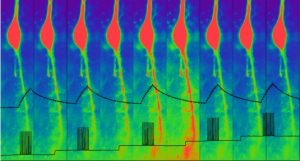Biology text books explain that the brain’s neurons talk to each other via action potentials. These electrical all-or-none impulses are a form of digital information transmission – just like  a CD player digitally decodes music. In a recently published paper* we describe how some sensory cells employ a very different form of information transmission. This transmission is analog and signal strength can vary over a wide range. We discovered that neurons in the nervous system of the sea slug Aplysia californica use analog fluctuations in global calcium concentration to determine when and how much sensory information the brain receives. While such analog forms of transmission have been described in a variety of organisms – including mammalian nervous systems – their underlying mechanisms have so far been elusive. With this new study we for the first time were able to visualize the calcium signals and to determine their origin within neurons. This newly described mechanism has great significance for understanding how nervous systems can control which sensory information reaches the central nervous system and which information is filtered out and ignored.
a CD player digitally decodes music. In a recently published paper* we describe how some sensory cells employ a very different form of information transmission. This transmission is analog and signal strength can vary over a wide range. We discovered that neurons in the nervous system of the sea slug Aplysia californica use analog fluctuations in global calcium concentration to determine when and how much sensory information the brain receives. While such analog forms of transmission have been described in a variety of organisms – including mammalian nervous systems – their underlying mechanisms have so far been elusive. With this new study we for the first time were able to visualize the calcium signals and to determine their origin within neurons. This newly described mechanism has great significance for understanding how nervous systems can control which sensory information reaches the central nervous system and which information is filtered out and ignored.
* Bjoern Ch. Ludwar, Colin G Evans, Monica Cambi, Elizabeth C Cropper (2017) “Activity-dependent increases in [Ca+2]i contribute to digital-analog plasticity at a molluscan synapse” Journal of Neurophysiology, ePub ahead of print, DOI: 10.1152/jn.00034.2017
Filed under: Biological & Environmental Sciences

